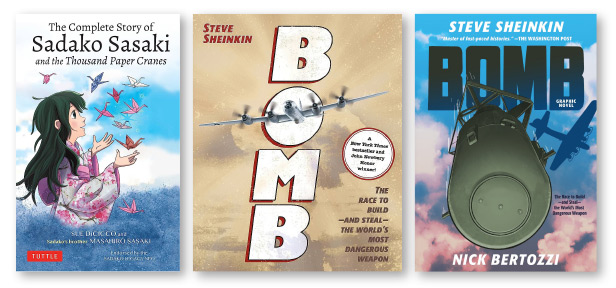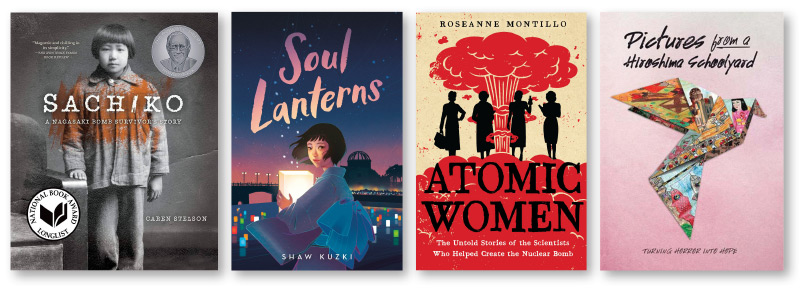Oppenheimer–Related Reading for Students
Suggest these age-appropriate titles to those wanting to learn more about the Manhattan Project and the devastating legacy of the bomb it produced.
With the release of the blockbuster film about Robert J. Oppenheimer this summer, many have found a new or renewed interest in the story of the atomic bomb. Here are some age-appropriate titles (and one documentary) for those who want to learn more about the Manhattan Project and the devastating legacy of the bomb it produced.

The Complete Story of Sadako Sasaki: and the Thousand Paper Cranes by Masahiro Sasaki & Sue DiCicco. Tuttle. 2020.
Gr 4-6–Sasaki, a survivor of the Hiroshima atomic bombing, and DiCicco, founder of the Peace Crane Project, have produced a moving account of the life and death of Sasaki’s sister, Sadako Sasaki. Only two years old when the atomic bomb was dropped on Nagasaki, Sadako did not begin to develop physical symptoms related to the event until she was in sixth grade. Once Sadako began to display symptoms of leukemia in 1955, the illness quickly hospitalized her and she died eight months after her diagnosis. Sadako’s father taught her the legend of the paper cranes during the final months of her life. The legend requires at least 1,000 paper cranes to be folded to earn a wish. Sadako folded many more than the minimum. After her death, the paper crane became a symbol of Sadako and her dream of universal peace and hope.
Bomb: The Race to Build—and Steal—the World’s Most Dangerous Weapon by Steve Sheinkin. Roaring Brook. 2012.
Gr 5 Up–The creation of the first atomic bomb wasn’t limited to the work of scientists. Savvy politicians, Norwegian commandos, and Soviet spies all played surprising parts. Sheinkin's riveting nonfiction storytelling and meticulous research, supported by period photographs, reveal just how exciting history and science can be. A Newbery Honor book and National Book Award finalist.
Bomb (Graphic Novel): The Race to Build—and Steal—the World’s Most Dangerous Weapon by Steve Sheinkin, illus. by Nick Bertozzi. Roaring Brook. Jan. 2023.
Gr 5 Up–“Harry Gold was right: This is a big story.” So begins this depiction of the “creation—and theft—of the deadliest weapon ever invented.” Sheinkin has brought his superior talent for storytelling to bear in what is a truly gripping account of discovery, espionage, and revolutionary changes in both physics and the modern world. This fascinating tale, packed with a wide cast of characters, focuses mainly on three individuals: spy for the Soviets Harry Gold, leader of the Manhattan Project J. Robert Oppenheimer, and Knut Haukelid, who sabotaged German bomb efforts while working for the Norwegian resistance.

Sachiko: A Nagasaki Bomb Survivor’s Story by Caren Stelson. Carolrhoda. 2016.
Gr 5-8–Sachiko Yasui was six years old when an atomic bomb was dropped on her hometown of Nagasaki: this is the account of her survival. She experienced the death of family members, homelessness, and ill health, but the unrelenting encouragement of her father gave her the strength and willpower to face the future. He had told her always to listen to her teachers and never be consumed by hate. Yasui also was influenced by her study of Mohandas Gandhi, Helen Keller, and Martin Luther King Jr. By the 50th anniversary of the bombing, Yasui was ready to speak publicly about surviving the blast and how it impacted her life. Her voice was strong and persuasive. Chapters that recount the story of her life alternate with chapters of historical overview and facts. The organization of this title makes it very practical for use in the classroom.
Soul Lanterns by Shaw Kuzki. Delacorte. 2021.
Gr 5-8–Even though the bombing of Hiroshima happened 25 years ago, 12-year-old Nozomi is discovering that the trauma of that day still lingers. At the annual Lantern Floating Ceremony to remember those who were killed, an older woman seemingly mistakes Nozomi for her mother. This puzzling encounter prompts Nozomi to wonder about her mother’s possible ties to the stranger. Shortly after, Nozomi’s art teacher becomes seriously ill and leaves school to convalesce. These situations lead to Nozomi and her friends’ increasing awareness of the long-term emotional and physical effects of the bombing. They dedicate their upcoming art club project to learning more about the experiences of their families and neighbors on that fateful day. Subsequent chapters focus on individual narratives told by survivors about losing loved ones during the bombing. Opening up about their loss and sharing their stories is cathartic for the survivors, unveiling new layers of understanding and compassion from the young listeners.
Atomic Women: The Untold Stories of the Scientists Who Helped Create the Nuclear Bomb by Roseanne Montillo. Little, Brown. 2020.
Gr 6-8–Montillo begins the narrative with Marie Curie’s radium discovery and then discusses the prevalent sexism Curie faced as a working mother. The author also unpacks the societal perceptions of some of the most important women in science, including Lise Meitner, Irène Joliot-Curie, and Joan Hinton. When some of these women were asked to work on the top-secret Manhattan Project, many seemed uncertain. Montillo’s detailed and organized writing stresses the importance of these women, who were as indispensable to the Manhattan Project. The back matter includes an author’s note, a scientific timeline, source notes, and bibliography.
Pictures from a Hiroshima Schoolyard. Dist. by the Video Project. 2015.
Gr 9 Up–This hour-long documentary tells two related stories through historical photos and interviews. The first tells of Honkawa Elementary School in Hiroshima; when the atomic bomb was dropped in 1945, more than 400 students and 10 teachers died. The school’s concrete walls enabled it to carry on amid the devastation. Teachers and students, including many war orphans, came from all over the area to repopulate the building. Food and basic supplies were scarce, hunger was widespread. Meanwhile, in Washington, DC, the minister of All Saints Church, A. Powell Davies, rallied his congregation and sent a care package containing school supplies and toys. In response, the children sent hand-drawn pictures expressing their gratitude. The church stored the pictures and organized an exhibition of the restored pictures in Hiroshima in 2010. The exhibition reunited the child artists, then in their 60s and 70s, with the pictures they had drawn. Their recollections, tearful and joyful, bring the story to life. This film does not gloss over the horrors of war but offers a hopeful antiwar message in recounting a gift that had great impact in many lives.
RELATED
Babies at the Zoo
Construction
Hooray for My Brain!
The job outlook in 2030: Librarians will be in demand
The job outlook in 2030: Librarians will be in demand
ALREADY A SUBSCRIBER? LOG IN
We are currently offering this content for free. Sign up now to activate your personal profile, where you can save articles for future viewing






Add Comment :-
Be the first reader to comment.
Comment Policy:
Comment should not be empty !!!